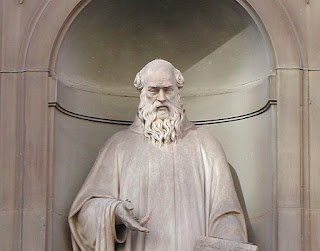WHERE DOES THE NAME OF THE MUSICAL NOTE COME FROM?
Guido d'Arezzo
As an introduction, we will say that since Prehistory there is musical archaeological evidence (bone flutes, whistles, Egyptian harps or metal wind instruments from Rome, among others). Unfortunately, we do not know what music sounded like in the early civilizations, since music was transmitted orally and there were no scores.
The creation of
the first musical symbols –the neumes- and their evolution towards the present
score, was a work of many centuries (task which is carried out even now because
new symbols are still being invented in order to perform contemporary scores).
Sounds have
always existed but, at some point in our time line, humans learnt to use some of
them musically. But, how were the name of the notes allocated?
The first reference that the Western world has about it is attributed to the Scientist and Mathematician Claudius Ptolemy (c. 100 – c. 170), who wrote a musical scale whose notes he named after the seven first letters of the Latin alphabet, id est: A, B, C, D, E, F, G.
Later, in the 6th century, the Philosopher Severius Boethius (477 – 524) used the names of the first fourteen letters of the alphabet in order to establish the name of the notes of a two octave musical scale (remember that letter J wasn´t added until the 16th century): A, B, C, D, E, F, G, H, I, K, L, M, N, O.
In the 11th century, the Benedictine monk well known as Guido d’Arezzo (995 - 1050) noticed in one of the prayers sung in his fellowship – the Hymn to St. John the Baptist- that each one of the seven verses begun with a note highest than the previous one. Then an idea was born in order to change the previous names given to the notes; he substituted the letters by the first syllable of every verse. Since then the notes have been called UT, RE, MI, FA, SOL and LA.
Some centuries later, the Italian musicologist Giovanni Battista Doni (1593 - 1647) changed it again, because it was very difficult to sing, the syllable UT. He decided to change it to our current DO. What is the origin of this new name? Apparently, Doni took the first syllable of the word Lord in latin: DO–mi-nus… although according to gossip he changed it because it was the first syllable of his own second name.
Finally the note SI was added. For that purpose the Hymn to St. John the Baptist was taken again and the syllable SI comes from every initial of the two words from its last verse: Sacte Ioannes.
Nowadays the two systems, alphabetic and syllabic, coexist. The former is used, mainly, in English or German spoken countries whereas the latter is used around the world (although in some places the name SI has been changed to TI).
Interestingly in German spoken countries letter B was changed to H.
Examples:
UK: A, B, C, D, E, F, G.
GERMANY: A, H, C, D, E, F, G.
SPAIN: LA, SI, DO, RE, MI, FA, SOL.
U.S.A.: LA, TI, DO, RE, MI, FA, SOL or A, B, C, D, E, F, G.
The first reference that the Western world has about it is attributed to the Scientist and Mathematician Claudius Ptolemy (c. 100 – c. 170), who wrote a musical scale whose notes he named after the seven first letters of the Latin alphabet, id est: A, B, C, D, E, F, G.
Later, in the 6th century, the Philosopher Severius Boethius (477 – 524) used the names of the first fourteen letters of the alphabet in order to establish the name of the notes of a two octave musical scale (remember that letter J wasn´t added until the 16th century): A, B, C, D, E, F, G, H, I, K, L, M, N, O.
In the 11th century, the Benedictine monk well known as Guido d’Arezzo (995 - 1050) noticed in one of the prayers sung in his fellowship – the Hymn to St. John the Baptist- that each one of the seven verses begun with a note highest than the previous one. Then an idea was born in order to change the previous names given to the notes; he substituted the letters by the first syllable of every verse. Since then the notes have been called UT, RE, MI, FA, SOL and LA.
Some centuries later, the Italian musicologist Giovanni Battista Doni (1593 - 1647) changed it again, because it was very difficult to sing, the syllable UT. He decided to change it to our current DO. What is the origin of this new name? Apparently, Doni took the first syllable of the word Lord in latin: DO–mi-nus… although according to gossip he changed it because it was the first syllable of his own second name.
Finally the note SI was added. For that purpose the Hymn to St. John the Baptist was taken again and the syllable SI comes from every initial of the two words from its last verse: Sacte Ioannes.
Nowadays the two systems, alphabetic and syllabic, coexist. The former is used, mainly, in English or German spoken countries whereas the latter is used around the world (although in some places the name SI has been changed to TI).
Interestingly in German spoken countries letter B was changed to H.
Examples:
UK: A, B, C, D, E, F, G.
GERMANY: A, H, C, D, E, F, G.
SPAIN: LA, SI, DO, RE, MI, FA, SOL.
U.S.A.: LA, TI, DO, RE, MI, FA, SOL or A, B, C, D, E, F, G.



Comments
Post a Comment